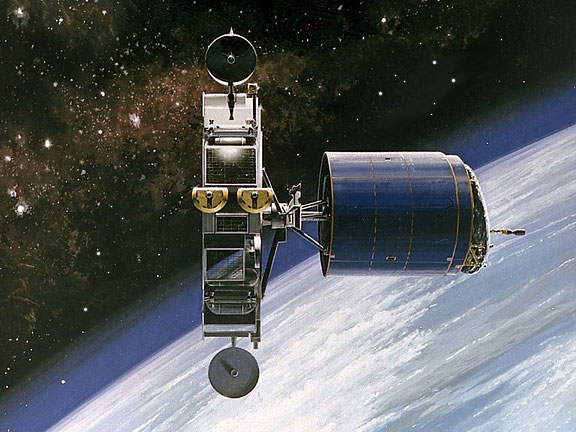What is clearly needed is a fast-paced program to replace the shuttle's capability with the existing heavy launcher (Atlas and Delta) capabilities and a new LEO space tug (LEOT). There are a number of required components to such a program.
1. Make sure that any payloads launched to LEO can be located, mechanically acquired and safely captured by the tug.
2. Build a set of 3 LEO tugs that can retrieve a payload from anywhere in the space station's orbital plane (within a degree or two of the plane. We assume that the tug might weigh up to 20 tons with some stored propellant on board. It could thus be launched itself by one of the Atlas or Delta Heavies.
3. Build a small propellant depot that could be docked to the space station on a long boom. The depot would have venting safety systems to protect the station from being "spun up" by any uncontrolled leakage and would store only non-hypergolic propellants due to safety. The depot could alternately have a small engine and be placed near the station; it could follow the station during any re-boosts using its own propellant. The small depot should have enough capacity to re-fuel the LEO space tug.
4. Design the mini-depot to be able to re-liquefy its propellants as fast as they boil off; with dewar-style tank designs and sunshades to reduce the boil-off rate. The depot would be powered by its own solar panels. Adequate electrical power is critical to being able to re-liquefy the propellants.
5. The propellants stored could be LOX and RP1 or Methane, to reduce the higher power levels needed to re-liquefy liquid hydrogen.
6. Design the depot so it could be launched by one of the current (Atlas or Delta) heavies.
7. Create a COTS-like competition to build a tanker system using any of the existing non-heavy booster configurations to replenish the depot. As part of the deal, the government would agree to launch service guarantee contracts with the winning company (a specified number of launches during a specified period of time at a specified price per launch).
8. Manage the program all-up so that all components become available for use at about the same time.
Such a space tug development program has lots of advantages.
1. It would have a near-term effect on reducing the space job problem.
2. It would soon replace the capacity of the shuttle of delivering heavy cargos and large modules to the station. This would allow resumption of near-term planning and construction of new space station modules such as the critical centrifuge facility, and additional crew hab space.
3. Initiation of such a concrete program would quickly demonstrate the current administration's intent to pursue human space operations.
4. It would demonstrate and prove out the in-space re-fueling system required for beyond-LEO exploration, and quickly gain us invaluable experience needed for building larger depots and tugs.
5. It could be modified for crew rescue, or, with a docked hab module, create a crew rescue vehicle that could rescue any crew stranded in or near the space station's orbital plane.
6. It would stimulate into existence the system of small tanker vehicles that would be require to re-supply the larger fuel depots that would be built after 2020.
7. It would provide greater flexibility and safety in re-boosting the space station if the VASIMR engine system is not implemented by then.
8. Much larger versions of it (High Earth Orbit Tugs (HEOTs) would be able to reach Geosynchronous Earth Orbit and lunar orbit and repair or move problem communications satellites like the currently drifting one, which is now menacing other satellites. It seems crazy that we have this enormous global multi-billion dollar investment in comsats, with still no way to repair, refuel or control them other than with remote radio commands.
9. The same larger tug could be used as the basis for an LEO - to High Earth orbit and lunar orbit in-space ferry system, with return of the tug to LEO facilitated by the use of aero-braking and subsequent orbital adjustment (circularization). This large re-usable tug would replace the expendable earth departure stage of the Constellation. It would open the way for a similar depot-based infrastructure to be built up in the Geostationary and Lunar orbits, which would then allow relatively inexpensive access to the lunar surface. The HEOT tug would be recovered by slow, multi-pass aero-braking, returning to a LEO station and depot.
10. Progress is being made at Ames and other centers which will allow the design of narrower aero-capture (single-pass) crew return vehicle designs, able to return to LEO from GEO and beyond, without the very wide and hard-to-launch shape of a cone-shaped Apollo or Orion capsule. This will allow the "service module" portion of the crew vehicle to remain as an integral part it during aero-capture into LEO, making the whole vehicle re-usable. The HEOT would return separately from the crew vehicle via the slow aero-braking method; both would rendezvous with a station and depot.
11. The combination of a large tug, Orion-derived crew vehicle designed for aero-capture and compatible habitat module would thus lead to the ability to take crews far beyond LEO and GEO, such as to asteroids or Mars orbit. Much of the expertise that went in to the design of the Orion capsule could be used in expanding the tug/crew vehicle/habitat design. An Orion capsule all by itself is obviously of little use in long-distance missions. It would need a propulsion module and a hab module for such trips, where a larger tug could serve as the propulsion system. Such a whole in-space transportation system based on separately launchable crew vehicle, propulsion and hab modules would be much easier to design and launch than an integral system. These vehicles would not be used for Earth to orbit and back transport. They just need to be placed into LEO before they can be used!



